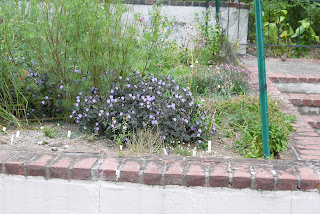 |
| Commelina virginica |
 |
| Commelina virginica |
 |
| Commelina sp ex Karen Petersen |
 |
| Tinantia pringlei Berkeley form |
 |
| Aneilema aequinoctiale |
 |
| Aneilema aequinoctiale |
 |
| Aneilema aequinoctiale |
 |
| Commelina africana |
 |
| Commelina africana |
Found a few more recent photos from this fall, and it seems indeed that I do like commenilids, to the point that I grow several species. I found my plant of Commelina virginica in coastal South Carolina but it has a much wider range. It is a rather short upright growing plant and although the flowers are not bad looking, they are fleeting even by commelinid standards. It remains to be seen how hardy it will be in my garden, while I am certain hardy ecotypes exist this plant didn't come from a very cold area so it remains to be seen how permanent it will be. In any case I did collect seed, which is a tedious process for most commelinids except a couple which I will mention later on. Basically one has to collect the dried bracts from which the flowers emerge, these will contain the oblong seed pods within. Then one rubs the pods until the single seed, or occasionally two, is released.
Another blue flowered species is one that Karen Petersen collected seeds of, I think it came from Kenya. It is more showy than our native species, and readily self sows into other pots near it and can withstand considerable drought. Like all of them it propagates easily from cuttings or seeds.
I just posted about Tinantia pringlei only to find a photo confirming what I suspected, that yes indeed I do have the Berkeley form also growing in the backyard in a different garden than the Plant Delights form. And as can be seen the leaves have markedly fewer spots than the PD form. To some extent spotting depends on amount of sun too, so both genotype and exposure are factors in just how many/dark the leaf spots will be. Like most of its family that I grow, it requires no particular attention and just seems to pop up here and there and take care of itself. Should it have too many offspring as many of its kin are prone to doing, they are easily removed so that populations can be managed in the garden without too much trouble.
Aneilema aequinoctale is a vigorous tender perennial from South Africa and points north which will self sow for me. It creates a spreading ground cover from which short panicles of yellow flowers emerge. It is easy to harvest seed of this one, no messy bracts to sort through, just look out for the ripe small pods and rub them apart to get the round seeds within. It thrives in warm weather and appears to prefer some shade and decently moist soil.
Commelina africana comes in several forms and indeed I collected seed of several different ones years ago in Botswana and South Africa. One form has persisted over the years, being an excellent self sower and profuse bloomer. It does best at the edge of a garden, where it can trail out into the patio or onto the top of a stone wall. To harvest seeds, the easiest thing to do is to lift the plant's branches that extend over the stone and look for the elongated seeds lying right under the plant. They are easy to pick up and any that escape attention (and many will) become next year's plants. It is perennial in nature but severe winter cold makes it a resowing annual here. Its not by any means the most showy of plants, or even of its family, but I enjoy it, making sure it doesn't stray far from the areas I allow it to grow in.


























